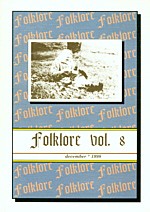On the Relationships of the Rhetorical, Modal, Logical, and Syntactic Planes in Estonian Proverbs (part 2)
On the Relationships of the Rhetorical, Modal, Logical, and Syntactic Planes in Estonian Proverbs (part 2)
Author(s): Arvo KrikmannSubject(s): Customs / Folklore
Published by: Eesti Kirjandusmuuseum
Summary/Abstract: The clearest and most effective indicators of the stereotypicality of proverbs are not, however, the basic formulae of logic and degrees of modality or the basic patterns of semantic transformations or other similar constructs, but rather syntactic clichés with their more or less clear correlations with stereotypes occurring on other levels. Similarly, the well-known formula-like, or ornamental character of proverbs which has led some scholars to believe that it is possible to subject proverbs to a logical description, manifests itself first and foremost as syntactic symmetry (in Estonian inevitably accompanied by morphological symmetry). In the proverbs of Baltic- Finnic peoples (Finns, Karelians, Estonians, Votes) whose fondness of the so-called ‘runic verse’ can be observed in a considerable part of their “metric” folklore in several genres, structural symmetry is particularly frequent and pure, especially as compared to German or Russian proverbs, for example, in which end rhyme with its anti-parallelist effect is much more frequent. Syntactic symmetry is, by nature, yet another aspect of parallelism. Having – in the above discussion of the logical structure of proverbs – pointed out a parallelist supra-implicational level, we should like to emphasize that in proverbs, manifestations of parallelism are certainly not confined to this supra-level, but reach the basic implicational level as well.
Journal: Folklore: Electronic Journal of Folklore
- Issue Year: 1998
- Issue No: 8
- Page Range: 51-49
- Page Count: 49
- Language: English

